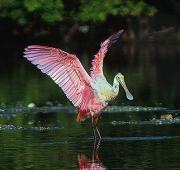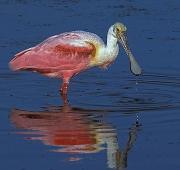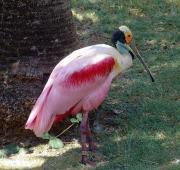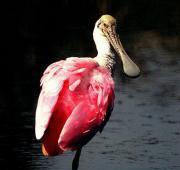 Roseate Spoonbill
Roseate Spoonbill
Classification and Evolution
The Roseate Spoonbill is a large species of wading Bird, found from the Gulf Coast of the United States to Argentina at the tip of South America. The Roseate Spoonbill is one of six Spoonbill species found across the world, and although they all inhabit warmer, tropical climates, the Roseate Spoonbill is the only one that is found in the western hemisphere. Like all Spoonbill species, the Roseate Spoonbill is named for it's spatula shaped beak, which becomes flatter and broader towards the end, allowing the Roseate Spoonbill to scoop food out of the water with ease. They are closely related to other large wading Birds including, Herons, Storks and Egrets and are often mistaken in Florida for Flamingoes, particularly by tourists.

Anatomy and Appearance
The Roseate Spoonbill is said to be one of the most distinctive Birds found in North America, with their pink and white plumage, orange tail-feathers, red legs and eyes and black feet. Like all wading Birds, the legs of the Roseate Spoonbill are thin and very long, allowing them to walk about in the shallow waters without getting their head or feathers wet. Their distinctively long beak is very sensitive to enable the Bird to easily detect the presence of prey, and has two small slits close to the top meaning that the Roseate Spoonbill can still breathe whilst it's beak is submerged in the water. The skin on their head is featherless and often has a greenish tinge to it, leading to their lighter coloured beak.

Distribution and Habitat
The Roseate Spoonbill is found along North America's Gulf Coast, most notably in Texas and Florida. It's range extends through Central America, down to Argentina at the bottom of the South American continent, and they can also be found on islands like the Bahamas, the Caribbean and Cuba. The Roseate Spoonbill can be found in fresh, salt or brackish waters, where the water level is low and is close to roosting sites. The Roseate Spoonbill is most commonly found in shallow wetlands from bays and estuaries, to mangrove swamps and tidal ponds. Despite drastic falls in population numbers in the USA in the late 1800s, the Roseate Spoonbill colonies there are now healthy and sustainable through much of their native regions.

Behaviour and Lifestyle
The Roseate Spoonbill is a very sociable Bird that inhabits it's wetland homes with other Roseate Spoonbills, and they are also commonly found in the presence of other waders including Herons, Egrets and Ibises which they are closely related to. The Roseate Spoonbill is a fairly large Bird, making it's flying style long and slow. They fly together in small flocks in diagonal lines with their necks and heads outstretched, when moving between habitats or migrating to their annual nesting sites. The Roseate Spoonbill is often seen in small flocks when feeding but they have also been found to do this on their own as well. In the wild, they are known to be particularly shy Birds, with the whole colony known to fly away if startled, but have been known to adapt well to Human disruption when kept in captivity.
Roseate Spoonbill Reproduction and Life Cycles
The Roseate Spoonbill is a colonial nester, meaning that they gather in large numbers to produce and rear their young, possibly for protection. Roseate Spoonbills reach sexual maturity at the age of 3 or 4, when they migrate to appropriate nesting grounds to find a mate. Once paired up on coastal islands, both the male and female construct a nest in trees, thick bushes or reeds where up to four eggs are laid per clutch. The Roseate Spoonbill chicks usually hatch after an incubation period of around three weeks, and fledge after about a month. The young Roseate Spoonbills have white plumage with a slight pink tinge, and often won't develop the colourful adult feathers for at least a couple of years. Both the incubating of the eggs and the feeding of the chicks is shared by the male and female parents.
Roseate Spoonbill Diet and Prey
The Roseate Spoonbill is an omnivorous animal that uses it's spoon-like beak to catch small animals in the water. The Roseate Spoonbill sweeps this distinctively shaped bill from side to side close to the bottom of the water, creating little whirlpools of water that trap prey inside them, enabling the Roseate Spoonbill to feed. Although they will eat a number of both plant and animal species, small Fish such as Minnows are the primarily source of food for the Roseate Spoonbill, comprising roughly 85% of it's diet. The rest is made up with the consumption of other small aquatic organisms like Shrimp, Molluscs and aquatic Insects that lurk close to the muddy bottom, along with a number of aquatic plant species.
Roseate Spoonbill Predators and Threats
Despite the large size of the Roseate Spoonbill, it is not uncommon for them to be hunted by hungry predators. Alligators in the water, along with felines like Pumas and Jaguars are the most common predators of the adults in their natural environment, but it is Humans that pose the biggest threat to them, mainly through hunting. The eggs and more vulnerable chicks of the Roseate Spoonbill are in even more danger as they are preyed upon by a variety of species including Raccoons, Coyotes and Hawks. One of the biggest threats to Roseate Spoonbill populations today is the loss of their native habitats, mainly seeing that many of these natural wetlands have been either drained or pollution has caused the water to become contaminated.
Roseate Spoonbill Interesting Facts and Features
Despite it's very distinctive appearance, the Roseate Spoonbill is often mistaken for other Birds like the Flamingo, particularly when in flight, even though they are generally smaller in size and have a longer, wider beak than these pinker Birds. Not only is their distinctive spoon-like bill useful for catching food though, but there are also very sensitive nerves at the end, which causes the Roseate Spoonbill's beak to snap shut quickly when it comes into contact with small aquatic organisms. It is widely believed that the reason for the bright pink plumage of the Roseate Spoonbill, is due to the algae eaten by the Crustaceans that these Birds consume (in a similar way to the Flamingo but not quite as bright).
Roseate Spoonbill Relationship with Humans
The Roseate Spoonbill is known to be very wary of Human presence, quite probably because the populations in Florida particularly, where hunted almost to extinction in the mid to late 1800s for their plumage. It is thought that populations were originally affected as these Birds commonly socialize with other waders including Egrets, which were a prime target for hunters who sold their lush feathers to go into the making of luxury ladies garments in particular. With the almost extinction of this species in North America at the turn of the century, awareness of their loss became more apparent, finally leading to their protection and conservation of their habitats in the mid 1940s.
Roseate Spoonbill Conservation Status and Life Today
Today, the Roseate Spoonbill is listed as an animal that is of Least Concern of becoming extinct in the wild in the immediate future. With populations having re-built and sustained themselves since they were listed as a protected species in the 1940s, this big wader is once again found in large numbers through much of it's natural range. However, despite not being hunted so much any more by Humans, the Roseate Spoonbill is being affected by habitat loss in many areas, which is mainly caused by water pollution.

